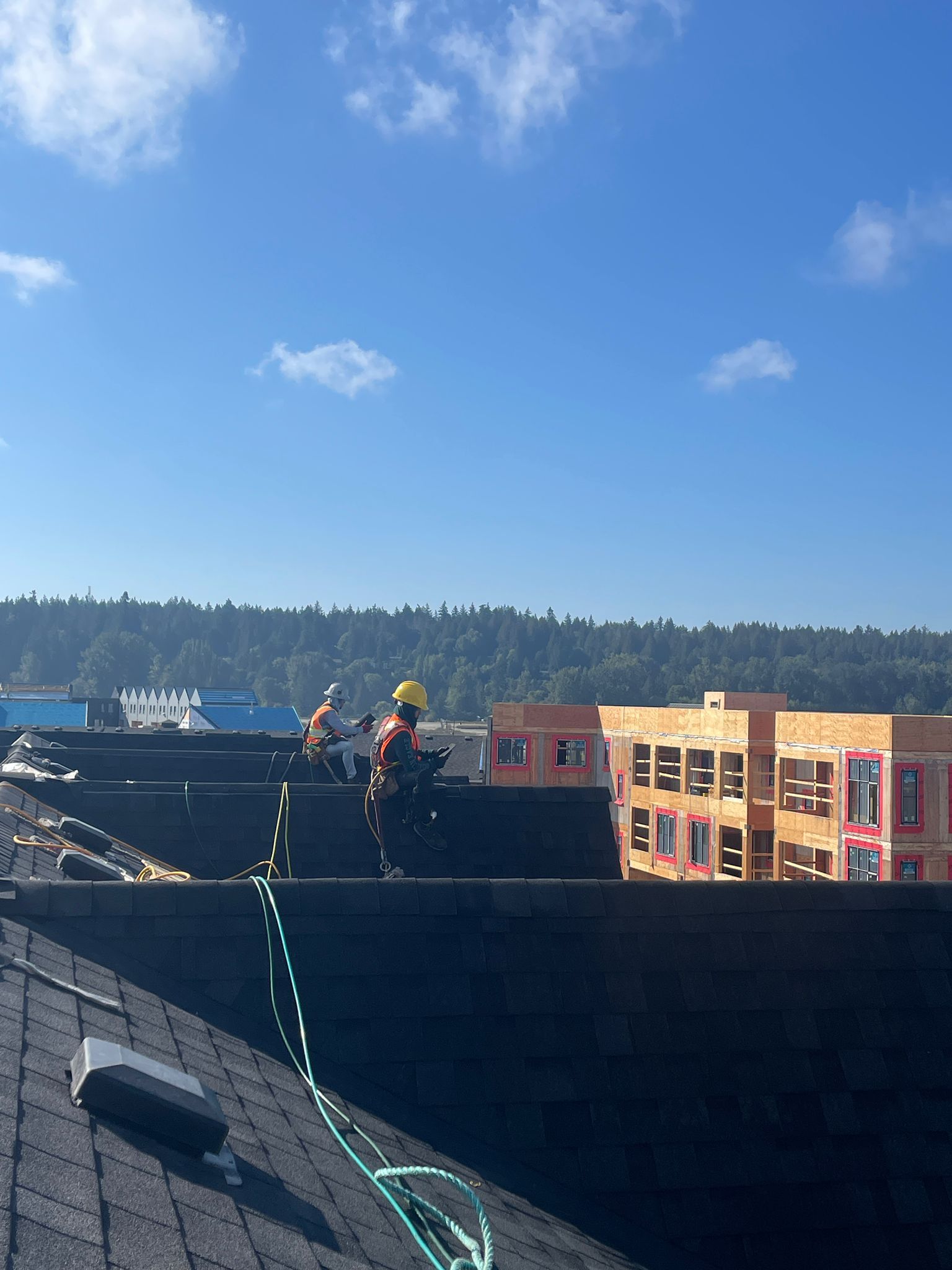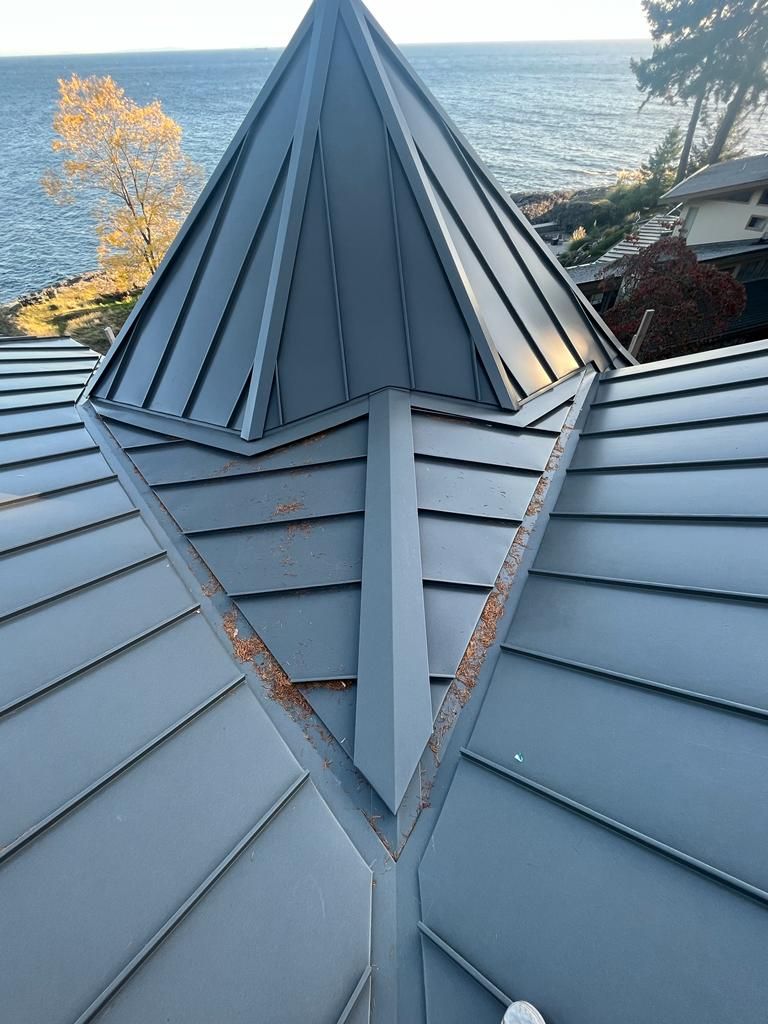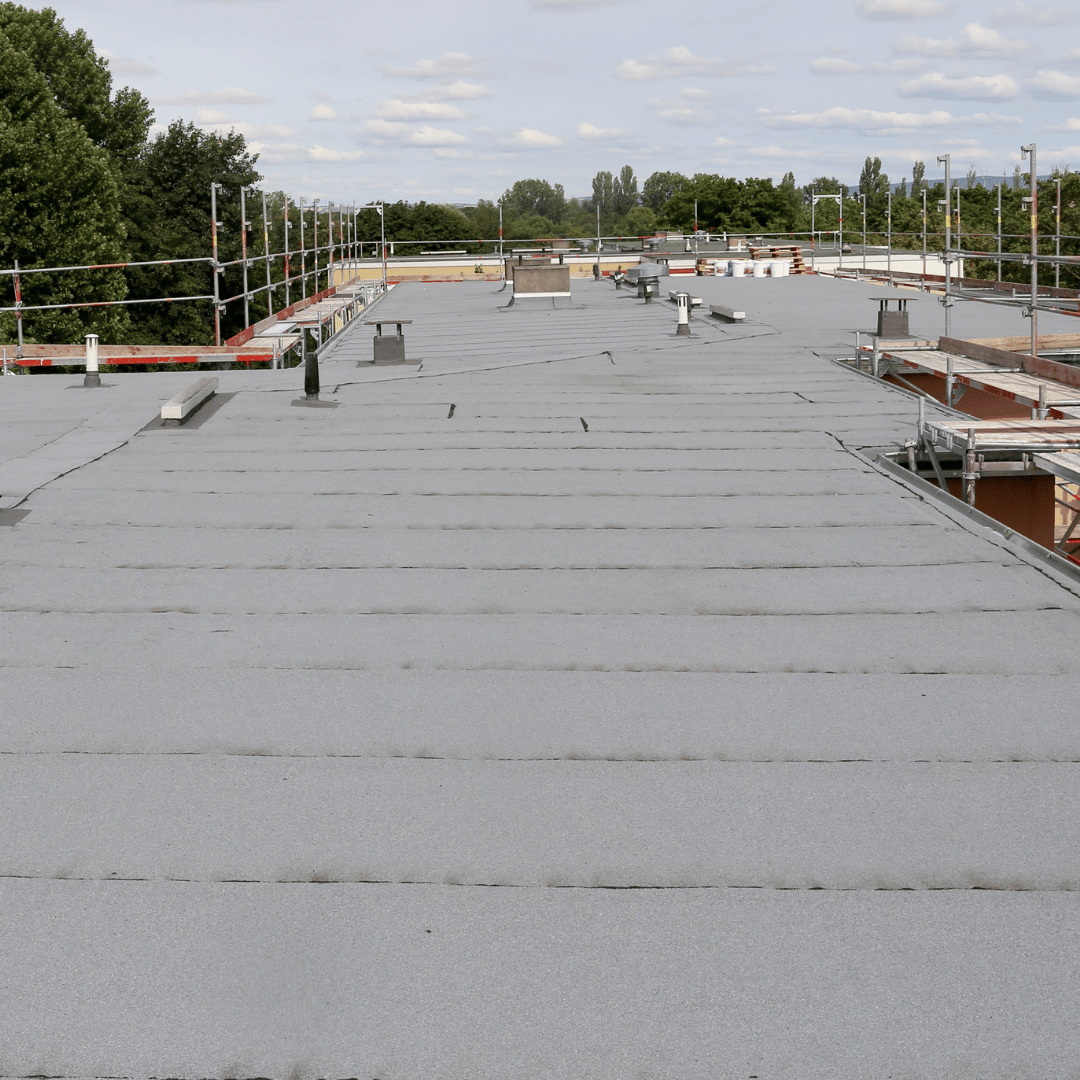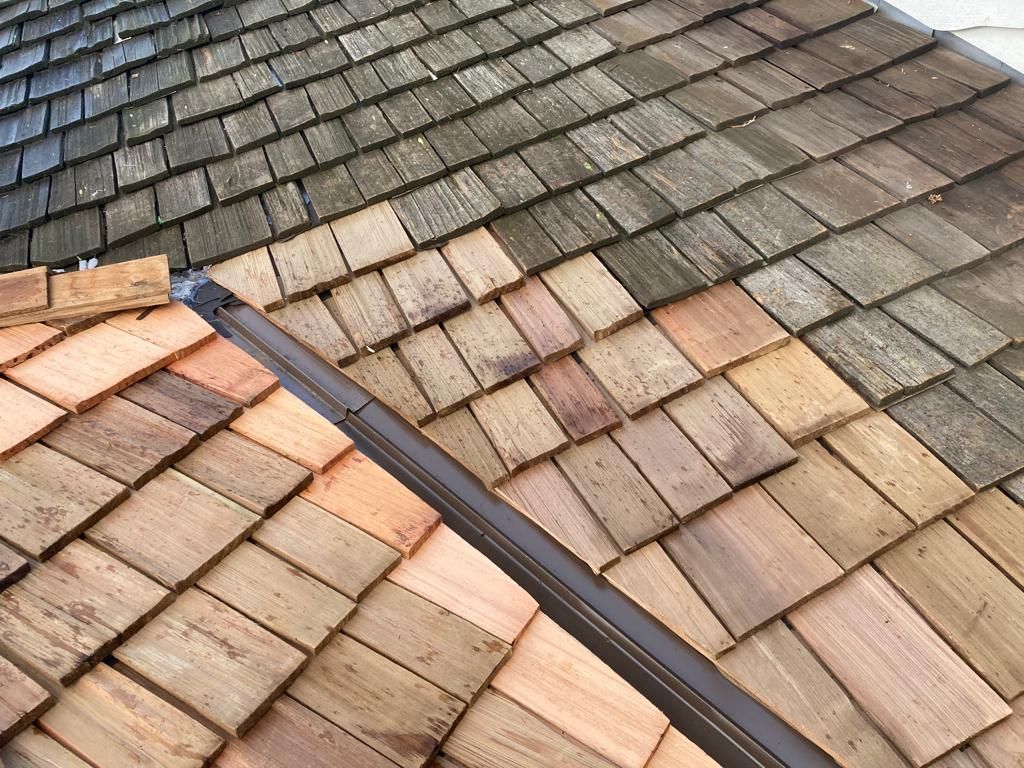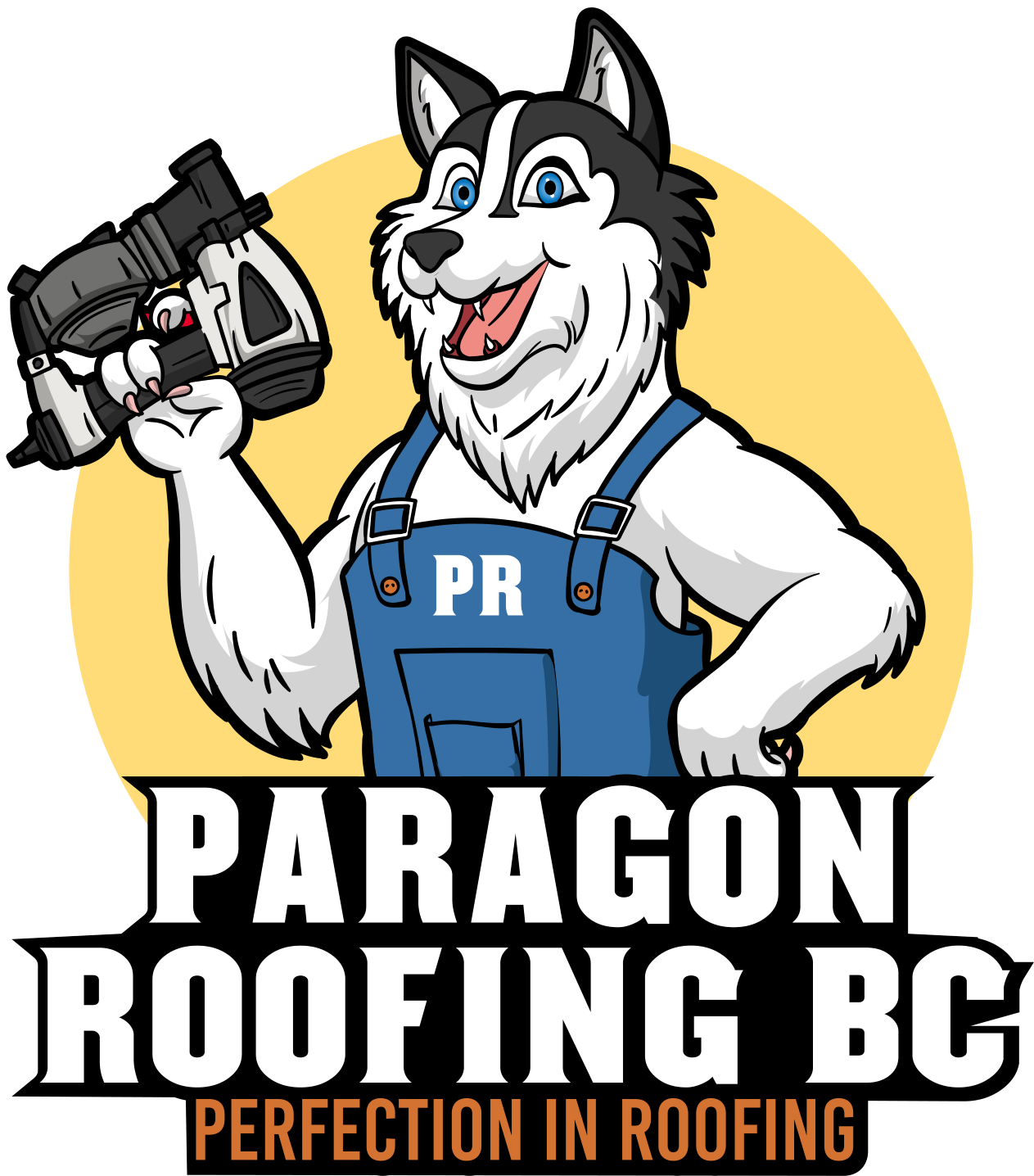Call Today
12233 92 Avenue, Surrey, British Columbia V3V 7R9, Canada
Reach Out
CALL US TODAY · 604-358-3436
Expert Roofing Solutions for Townhouses in Coquitlam: Paragon Roofing BC’s Community-Focused Approach
Discover essential winter roofing tips and real-life stories from Coquitlam townhouse owners to protect your home from costly seasonal damage.
WINTER DISASTERS WE’VE TACKLED IN COQUITLAM TOWNHOUSES
I’ve seen my fair share of snowy surprises over the years in Coquitlam and the surrounding areas. Sometimes I’ll share these stories, not to scare anyone, but to remind folks that winter can really test a roof’s endurance. There was one winter a few years back when the snowfall was heavier than usual. We got called to a
townhouse complex where an entire row of units had significant leaking. Picture this: the entire attic space was drenched, insulation was soaked, and the water was sneaking into living rooms and hallways. Tenants were placing buckets all over the place. Nobody wants an indoor slip-and-slide like that!
In that particular situation, I remember trudging through the snow during one of Coquitlam’s gloomier winter afternoons, with ice-cold slush seeping through my boots. The roof had multiple issues, but most of the trouble stemmed from ice dams forming along the edges. Combine that with poor ventilation in the attic and you’ve got water backing up in places it should never go. The meltdown eventually led to massive leaks. We ended up carefully chipping away at the ice in critical spots, tarping some areas, and working in subzero conditions to give those tenants peace of mind. Repairs took a bit of time because we wanted to do them right—from the top layers of shingles down to the attic insulation. Believe me, seeing folks relieved that they won’t wake up to water drips in the morning… that’s probably the best feeling as a roofer.
I’ve also helped homeowners (well, townhouse owners, but hey, home is home) who suffered partial roof collapses when the snow piled up unexpectedly. One such incident involved an older structure that hadn’t been inspected in years. During a particularly harsh week, the weight of the snow buckled a portion of the roof. Thankfully, no one was hurt. But that moment taught me that checking your roof’s structural integrity before the worst storms come can save you from a real hassle—like having to set up an emergency bunk in your neighbor’s living room.
It doesn’t always have to be dramatic, though. Sometimes we just see small leaks, or ice forming in the gutters. But let’s be real: any leak is too big when it’s dripping into your dining room. I’ve been proud to help folks around the Lower Mainland through these winter curveballs—especially because we often get less direct freezing temperatures compared to some of the colder provinces, but we do see slushy snow and unpredictable freeze-thaw cycles that can stress a roof in sneaky ways.
WHEN VANCOUVER’S RAIN AND COQUITLAM’S SNOW TEAM UP
Local meteorological data indicates that we’re prone to experiencing around
150 to 200 rainy days a year in some Metro Vancouver regions. Coquitlam, nestled against those lovely mountains, can see slightly higher rainfalls. Winter storms that carry moisture from the Pacific can suddenly drop a decent layer of snow, followed by rain that soaks into that snowpack. This melted water tries to run off, but if your gutters or drainage points are clogged or your attic ventilation is poor, you could end up with some serious trouble.
There was a year—maybe you recall—when we had a series of storms nicknamed the “Pineapple Express.” Warm air came in from the tropics, hammered us with heavy rainfall, and melted heaps of snow on rooftops. This combination can be a roof’s worst nightmare. I remember seeing estimates that across Metro Vancouver, up to 12% of roofs in certain neighborhoods ended up with leaks or some form of water infiltration during that series of storms. Townhouses aren’t exempt from that statistic. In fact, in multi-family settings, if your neighbor’s roof section develops a problem, it can sometimes spread or cause issues in your unit as well. Shared walls and shared drainage systems mean that water can travel in unexpected ways.
Snowfall statistics in Coquitlam can vary quite a bit year to year. Some winters might only bring a dusting, while others can bring heavy accumulations of 15 to 30 centimeters in a single storm. Those heavier storms may only come along once every few years, but they do happen. The data from Environment Canada suggests that while big snow events are less frequent, they can pose more danger simply because we’re not always prepared. Let’s be honest, folks in Surrey might start joking about “Snowmageddon” the moment there’s a centimeter on the ground, but up in higher elevations—like some parts of Coquitlam—the snowfall can be significantly more. Then once it melts, it morphs into unstoppable rivulets that can find any weakness in a roof system.
I’m not here to blame the weather, though. It’s just part of living in this rainy-snowy-lovely region we call home. But I’ve learned that if we’re mindful of how storms develop around here, and we keep up on basic maintenance, we can often sidestep those panicky phone calls at 2:00 AM about water dripping through a bedroom ceiling.
WHY TOWNHOUSES FACE UNIQUE ROOFING CHALLENGES
I’ve worked on a bunch of different roof types over the years—from single-family homes in Port Moody to tall condo buildings in Burnaby. Townhouses, though, bring their own special quirks. These buildings usually share walls, and sometimes they share roof lines or drainage systems. If there’s a design flaw in the roof that spans multiple units, that flaw can snowball into a bigger issue that affects numerous owners. Also, because multiple residents are often connected by a single strata or homeowners’ association, roofing repairs and maintenance might require collective decisions. That can delay critical fixes or seasonal maintenance if folks can’t agree on the best course of action.
Complex Roof Designs
Townhouse roofs might have multiple peaks, valleys, dormers, or transitions as they accommodate various unit layouts. More angles and corners mean more places where water can pool or snow can collect. With every extra seam or joint, there’s another potential area for leaks, especially during heavy rainfall or snow accumulation. Our Lower Mainland weather is the perfect test for these joints.
Shared Drainage
You might share a
gutter system or downspouts with one or two neighbors. If a neighbor’s section clogs up with leaves, it’s possible for your unit to suffer from water overflow. In Delta, you might joke that your neighbor’s yard is always full of random cedar needles from the big tree out front. Well, those needles can jam the gutters that connect to your unit, too.
Attic and Ventilation
Sometimes, townhouses skip out on adequate attic ventilation because the design might seem compact or restricted. Without proper venting, warm air from inside can melt the snow on the roof. Then, as the melted water moves to the colder edges of the roof, it refreezes and forms ice dams. Ice dams are basically big blocks of ice that can force water to go under the shingles and into your attic. Trust me, you don’t want that.
Coordinating Maintenance
Unlike a detached house, you might need permission or an agreed-upon plan for major roof repairs in a townhouse complex. I’ve seen instances where one unit’s occupant was super proactive, while their neighbor hadn’t touched the gutters in years. Balancing different attitudes toward maintenance can become a bit of a headache. It’s crucial for everyone to be on the same page, or at least have some guidelines that ensure the entire complex’s roof system is well cared for.
STORIES OF QUICK WINTER ROOF SAVES
I’ve had the privilege of helping numerous townhouse complexes navigate winter storms with minimal stress. One place in Coquitlam stands out. The call came in during a particularly icy night—sleet, rain, and leftover slush were all having a party on everyone’s rooftops. A large section of the top floor in one unit was experiencing slow but persistent water infiltration. By the time we arrived, the resident had a pile of soaked towels by the front door to keep water from spreading.
We carefully set up a temporary fix by using specialized tapes and a heavy-duty tarp to divert water. Did we look like giant gift wrappers slapping tarp on a roof? Kinda. But within a day or two, the rain subsided enough for a more thorough inspection. It turned out that a poorly fastened flashing around a rooftop dormer let water seep in. Over time, that water compromised some of the underlying plywood. Once that plywood started sagging a bit, the shingles couldn’t seal properly in that area. More water intrusion followed. We replaced the damaged plywood, installed new underlayment, and sealed up everything so the roofing materials could do their job properly.
Another winter rescue involved clearing an ice dam that had blocked an entire gutter system. Temperatures during the day were hovering just above freezing and dropped at night. That freeze-thaw cycle built an iceberg in the gutter. Water had nowhere to go but inside the building. We chipped away the ice in the most crucial spots (very carefully, so we didn’t damage the roof membrane or the gutters), then used heat cables to melt away stubborn ice sections. After that, we advised the strata council on installing a more robust attic ventilation system and some gutter guards to reduce future clogs. No big fancy sales pitch, just some straightforward suggestions. A year later, the caretaker told me they’d had no problems that winter. That’s the kind of feedback that keeps me going.
THE STATISTICS ON WINTER STORM-INDUCED ROOF FAILURES
If you look at local surveys from the last decade, an estimated
10 to 15% of residential properties in the Metro Vancouver area experience some form of significant roof issue after a strong winter storm. Now, not all of these are catastrophic. Some are just minor leaks or lifted shingles. However, a leak doesn’t stay “minor” if you ignore it—water damage only gets worse with time. Coquitlam, with its varying elevations and proximity to the mountains, occasionally sees more intense localized weather. That can push the percentage of roof troubles a bit higher.
Moreover, data indicates that big wind events combined with precipitation can cause immediate roof failures where flashings or shingles are blown off. Once the waterproof layers are compromised, water infiltration goes from zero to full-on drip-fest in no time. The shape of many townhouse complexes—often with multiple angled roof surfaces—can create wind channels that increase the force against certain sections of a roof. So even if we think of ourselves as living in a mild coastal climate, the combination of wind, rain, and occasional snow does add up to a real challenge for any roof system.
WHAT BUILDING CODES SAY ABOUT RAIN AND SNOW LOADS
Here in British Columbia, the building code outlines requirements for roof structures to withstand specific loads—both live (like snow) and dead (the weight of the roofing materials themselves). Metro Vancouver is considered a high-precipitation region, so extra care is typically recommended for drainage. While we don’t have the same snow loads as the BC interior or the northern regions, we still get instructions like:
- Slope Requirements: Many roofing systems are required to have a minimum slope to allow for proper drainage. Flat roofs in townhouse complexes still need slight pitches or special drainage to avoid ponding water.
- Snow Load Calculations: There’s a formula used by engineers to account for expected snow loads. In Coquitlam, these calculations might factor in about 1.5 kPa (kilopascals) to 2.0 kPa for snow load (or sometimes more, depending on the exact location and altitude). That’s a fancy way of saying your roof should handle a pretty hefty pile of snow.
- Ventilation Codes: Proper attic or roof cavity ventilation is often mandated. The code wants enough air circulation to reduce condensation and ice damming. This includes guidelines on the ratio of vent area to attic floor space.
For heavy rainfall, roofs must be designed to drain water quickly and effectively. Gutters, internal drains, scuppers, or other systems must align with local requirements. While the code doesn’t usually specify the brand or type of gutter, it does specify capacity. This ensures that when we get those torrential downpours, the drainage system can handle the flow without immediate overflow.
Now, I’ll be the first to admit that building codes can be a little dry to read. But they do serve a purpose: They aim to keep our homes safe from structural failures. If you’re ever curious about whether your townhouse roof meets these standards, you can ask your strata council for the original building specs or consult with a professional. It’s not about being paranoid; it’s about being prepared.
ROOFING PROBLEMS THAT SHOW UP WHEN THE TEMPERATURES DROP
We all know winter in Coquitlam: one day it’s sunny and cold, the next day it’s raining sideways, and by the weekend there might be a layer of snow. Here are some of the common roofing issues that crop up during these ever-changing conditions:
1. Ice Dams
As mentioned, these form when snow melts on the upper part of the roof and refreezes at the cooler edges. The resulting “dam” traps water behind it. Over time, water infiltrates under shingles. This is more common in poorly insulated attics, where the heat escape causes uneven roof temperatures.
2. Condensation in the Attic
Especially noticeable in townhouses lacking proper ventilation. Warm indoor air rises, hits the cold underside of the roof deck, and forms moisture. Over time, that leads to mold, mildew, or even rot in the wood sheathing.
3. Damaged Flashing
The metal or rubber seals around roof penetrations (such as chimneys, vents, or skylights) can crack or lift during freeze-thaw cycles. Once flashing is compromised, water finds an easy path into your home.
4. Wind-Lifted Shingles
Heavy gusts, particularly in storms hitting from the Strait of Georgia, can lift shingles or blow them off entirely. A single missing shingle might be small potatoes initially, but over time, water can degrade the exposed underlayment.
5. Gutter Problems
Leaves, needles, or other debris in gutters can freeze into mini ice blocks. These block water flow and cause spillage. If left unchecked, water can spill over the gutter edge, saturate the fascia, or even seep into walls.
6. Attic Pests
Winter can drive critters like rodents to seek warm shelter. Attics or roof cavities with small openings can become their new hangout. This can lead to chewed insulation, droppings, or even damage to wiring.
7. Structural Sagging
Though less common, heavier snowfall or repeated freeze-thaw cycles can stress older or poorly built roof sections. That stress sometimes leads to subtle sagging, which might worsen with added weight.
DIY TIPS FOR WINTER ROOFING CARE
If you’re comfortable taking on some tasks yourself, there are a few steps you can do to help minimize winter roof problems. Always remember to prioritize safety. Slippery winter roofs are no joke, so if you’re not 100% confident, it’s best to wait for safer conditions or consult a pro.
- Clear Debris from Gutters
Before the worst of winter hits, grab a stable ladder (and a friend to spot you if possible). Clear out leaves, needles, or any gunk in your gutters. Flush them with a garden hose to ensure water flows freely. This helps reduce ice dams and overflows. - Trim Overhanging Branches
If you’ve got a tree that loves to drop branches or needles onto your townhouse roof, trimming those branches can prevent a buildup of extra debris. It also reduces the risk of branches scraping or damaging your shingles during windstorms. - Check Attic Insulation
Pop your head into the attic and see if the insulation is at an adequate level. You don’t have to become an insulation expert. Just look for any thin or bare spots. If you see the floor joists clearly, you might need more insulation. Even distribution is key to preventing hotspots on the roof. - Look for Visible Damage
If you have a safe vantage point, check for missing shingles, damaged flashings, or worn-out sealant around roof features. Identifying these before a storm can save you from a nasty leak later. If you see something suspicious, consider at least a temporary patch or cover before the weather worsens. - Monitor Attic Ventilation
While in the attic, see if there’s any obvious sign of moisture buildup—like damp insulation or water stains on the wood. If the air feels super stale or you notice mildew, it might be that your vents are blocked or undersized. Clear any vents you can safely reach. - Rake Off Excess Snow
In the event of a big snowfall, you can use a roof rake to remove some of the snow near the roof edge. It’s best not to climb on a snowy roof, so extendable rakes let you stay on the ground. Removing that first couple of feet of snow can slow or prevent ice dam formation. - Set Up Easy Drain Paths
Sometimes in multi-unit townhouses, the walkway, or shared yard area, might direct water or melt-off toward certain corners. If possible, keep those paths clear of piled-up snow or debris, so melting water doesn’t sit around and seep into your foundation or siding.
WHEN TO SEEK PROFESSIONAL HELP
As much as I believe in the power of DIY, there are times when calling in a trained roofer is just the safer, quicker, and more reliable option. For example:
- Major Leaks: If water is streaming in or you’re noticing widespread wet spots in the ceiling, you’ll want a thorough inspection. You’d hate to fix a superficial spot and miss a bigger underlying problem.
- Structural Concerns: If you suspect your roof is sagging, or if you notice cracking sounds, that indicates a bigger load or compromised framing.
- Extensive Ice Dams: Chipping away at large, stubborn ice dams can be risky. Professionals have tools like low-pressure steamers or heating cables, plus the know-how to avoid damaging shingles.
- Ventilation Upgrades: Installing soffit vents, ridge vents, or baffles often requires specialized knowledge to keep the airflow balanced. Doing it incorrectly could make moisture problems worse.
- Flashing Work: Replacing or properly sealing flashings around chimneys or skylights takes precision. A poor seal will just lead to repeated leaks.
The goal is always to ensure your roof weathers the storm without turning your living space into a water park. Sometimes a small, well-timed professional fix prevents a much bigger headache down the line.
BEST PRACTICES FOR TOWNHOUSE ASSOCIATIONS AND STRATA COUNCILS
In many townhouse complexes around Coquitlam, Burnaby, or even out in Surrey, the strata council or homeowners’ association plays a central role in maintaining common areas, which often includes the roof. If you’re part of such a council or you’re a resident who wants to bring issues up, here are a few best practices:
- Regular Roof Inspections: Schedule at least an annual inspection by a qualified roofer. Document the findings so you can track any developing problems year over year.
- Maintenance Funds: Ensure the budget includes a reserve for roof repairs and eventual replacement. We all know money talk can get tricky, but having that reserve can drastically reduce stress when urgent repairs pop up.
- Clear Communication: If one unit identifies a potential roof leak, share that info promptly with neighbors or the strata manager. Water doesn’t respect unit boundaries.
- Plan Ahead for Replacement: Townhouse roofs typically have a life expectancy of 20 to 25 years in Coquitlam and throughout the lower mainland (depending on materials). Don’t wait until year 24 to start discussing it. Proper planning ensures you can do a replacement in a timely manner without rushing into poor decisions.
- Seasonal Gutter Cleaning: Whether it’s a volunteer effort, a hired service, or a rotation among residents, keep those gutters free of debris. It’s one of the simplest ways to avoid leaks.
- Address Ventilation Concerns: If multiple units are seeing signs of mold or condensation, consider a complex-wide ventilation assessment. Sometimes small improvements in venting can cut down on winter roof issues significantly.
- Know Your Roof’s Design: Keep architectural plans and any previous roofing repair or replacement records on file. Future decisions become easier when you know what’s under the surface.
When these best practices become routine, a townhouse community can face the wildest winter storms with a whole lot more confidence.
WHY QUICK RESPONSES MATTER
During a winter event, problems can escalate within hours. A little drip can suddenly become a steady flow if the snowpack doubles overnight or if a freeze-thaw cycle repeats. The faster you act—whether with a DIY patch or by calling in help—the less likely you’ll have to replace moldy drywall or rotted plywood. I’ve seen families scramble to rescue their family photos or their heirloom rugs because of a roof leak that started small but grew out of hand. Nobody wants to be up at midnight shifting furniture around to dodge leaks.
Also, in townhouse communities, one unit’s problem can spread. Water infiltration in one attic can move through shared building elements. A quick response isn’t just about your unit; it’s about keeping everyone’s living spaces intact. That’s one reason I always encourage folks in a multi-unit setup to communicate with each other. You’d be surprised how many times a leak in one unit was discovered thanks to a neighbor’s heads-up about seeing water stains near the shared wall.
MY EXPERIENCES WITH PROACTIVE PREPARATIONS
Over the years, I’ve tried to nudge folks into proactive steps. There was a townhouse complex in Coquitlam that really took the initiative to heart. Before the winter season, they organized a “roof readiness day.” It was basically a community event where volunteers cleared gutters, checked roof vents from the attic side, trimmed nearby trees, and took note of any shingles that looked out of place. The strata also invited a roofing inspector to do a quick check for any major red flags.
This all happened in mid-fall. Come January, we had one of those big storms that dumped snow, followed by a swift warm-up and heavy rain. While surrounding complexes had some reported leaks, this particular community emerged relatively unscathed. I ran into one of the strata members a couple of months later at a local coffee shop. She was thrilled to say that their small event likely saved them thousands of dollars. I love hearing stories like that, because it reminds me that a small bit of prevention can go a long way.
STAYING HUMBLE AND HONEST ABOUT ROOFING CHALLENGES
I grew up here, so I know how quickly the Lower Mainland’s weather can flip. That’s why I never sugarcoat roofing challenges. I remember those early days of trudging around in the winter slush near Surrey Central, checking out older homes that were prone to leaks after each storm. People often ask if there’s a magic bullet solution—some fancy membrane or coating that solves everything. Reality is, a roof is a system, and it only works well when all components are in decent shape and well-maintained.
I also know budgets can be tight, and not everyone can afford a brand-new roof system at the drop of a hat. That’s why I’m keen on guiding folks to the solution that suits their immediate needs and longer-term goals. Sometimes it’s a quick patch to get you through the winter and a plan for more extensive repairs in the spring. Other times, it’s addressing critical ventilation issues that don’t cost a fortune but pay off big-time in preventing damage.
COMMUNITY-FOCUSED ROOFING IN THE LOWER MAINLAND
Townhouses contribute a lot to our sense of community, especially around Coquitlam, Burnaby, and Vancouver. You walk outside, see your neighbors, share a communal yard, maybe chat about your favorite sushi spots or the dreaded traffic on Highway 1. Being part of a townhouse community also means looking out for each other, especially when harsh winter weather strikes. A roof may seem like just another line item in the strata’s budget, but it’s literally the shield over everyone’s heads.
Over the years, I’ve discovered that a friendly, open approach to roofing fosters trust. People appreciate honesty about what really needs fixing versus what can wait. They appreciate an explanation of the problem in straightforward terms, not a bunch of jargon. And when we finish a job or see that the winter storms have passed with minimal damage, there’s a sense of relief—not just for me as a roofer, but for the entire community. It’s not about fancy marketing or big sales pitches. It’s about making sure families can sleep at night without worrying that their roof might cave in after the next storm.
ADDITIONAL TIPS FOR EXTREME WEATHER PREP
Since our weather can sometimes turn from drizzle to deluge, from mild flurries to a wet-and-heavy snowfall, it never hurts to have a more robust plan:
- Storm Kits: Keep some tarps, a roll of roofing tape, and a basic toolkit on hand. If a big branch ever damages your roof, a quick tarp job can mitigate water entry until a roofer arrives.
- Snow Shoveling Strategy: Make sure the shared walkways are cleared so that roofers (if needed) can access your property safely. If a roof is dangerously loaded with snow, professionals might need to safely clear it.
- Check Skylights: If your townhouse has skylights, ensure their seals are intact before winter sets in. Skylights are often a point of heat loss and can contribute to ice dam formation.
- Watch Your Ceilings: During or after a storm, glance at your ceilings, especially the corners near exterior walls. If you notice any staining, water droplets, or even peeling paint, act quickly. That’s often the first sign of a leak.
LOOKING AHEAD: THE FUTURE OF ROOFING IN METRO VANCOUVER
You might wonder if roofing technology is advancing in a way that will make these winter worries vanish. We do see new materials, better underlayments, and improved venting systems that handle moisture more effectively. Some townhouse complexes upgrade to more modern roofing materials—like specific synthetic shingles or advanced metal roofing—that boast better performance in high-moisture environments. But even with these improvements, basic maintenance remains key. A brand-new Ferrari still needs oil changes, right? Similarly, even fancy new roofs need the occasional checkup and care.
Additionally, as building codes evolve, we might see stricter requirements for drainage and insulation. Green roof systems or rooftop solar might become more common, adding new layers of complexity—but also offering potential benefits in insulation and water management. I’m personally excited to see how these innovations might reduce the typical headaches we associate with winter roofing season. However, the fundamentals stay the same: keep water out, allow moisture to escape, and ensure everything is properly sealed.
LEARNING FROM OUR WINTERS
Every winter teaches us something new. Some years, it’s a reminder that we should never underestimate how quickly ice can form. Other years, it’s that the combination of mild temperatures and constant rain can cause as much damage as a heavy snowfall. If you live in a townhouse, you’ve probably noticed that your vantage point on the roof is limited. You can’t just peek out a second-story window and see it clearly. So it helps to remain proactive, coordinate with neighbors, and have a small budget or plan in place for those “just in case” moments.
I find that when we share our collective experiences—like how Jim’s gutter froze last year or how Sarah had a small corner of her ceiling bubble with moisture—everyone learns. Then, hopefully, those of us who learn from these cautionary tales will take steps to avoid repeating them.
I hope this deep dive into winter disasters, quick fixes, and proactive steps helps you feel more prepared as a townhouse owner in Coquitlam or beyond. Our weather here can be unpredictable, but a little knowledge and a bit of elbow grease can go a long way toward keeping everyone’s roof in great shape. Stay safe out there, and always keep an eye on those gutters!
Can a small leak wait until spring for repairs?
It’s better not to wait. A small leak can escalate quickly during winter storms. Even a minor drip can lead to mold or structural damage if left unaddressed.
Are townhouse roofs more prone to leaks than single-family home roofs?
They’re not inherently more prone to leaks, but shared design features and drainage systems can create unique vulnerabilities. If one section fails, it can affect multiple units.
How often should gutters be cleaned in Metro Vancouver’s climate?
Ideally, at least twice a year—once in late fall (after most leaves have fallen) and once in spring. More cleanings might be necessary if trees overhang the roof.
Do ice dams occur often in Coquitlam or is that more of an interior BC thing?
Ice dams can happen in Coquitlam, especially in higher elevations or during the freeze-thaw cycles we sometimes get. Proper attic insulation and ventilation reduce the risk.
What’s the main reason roofs fail during winter storms here?
Generally, a combination of heavy precipitation (rain or snow), poor ventilation, and neglected maintenance leads to the bulk of failures. Wind can also lift shingles.
: Is raking snow off a townhouse roof safe?
It can be if done from the ground with a proper roof rake. Climbing on a snowy roof is risky. If snow loads get extreme, it’s best to consult a professional.
Are metal roofs a better option for townhouses in rainy-snowy climates?
Metal roofs can be durable and shed snow well, but they can also be more expensive. They’re a good choice if installed correctly and if the structure is properly designed for them.
How do I know if my attic has enough ventilation?
Look for signs of moisture: mold, mildew, or condensation on the roof deck. Check if vents are unblocked. Professional inspections can also measure airflow rates.
Could adding insulation solve my winter roof issues?
Adding insulation helps keep the roof surface at a stable temperature, reducing ice dams. But you also need sufficient ventilation to avoid trapping moisture.
Are there local codes about how much snow a townhouse roof must handle?
Yes, the BC Building Code sets guidelines for minimum snow loads. The specific requirement can vary by elevation and microclimate.
If one townhouse unit has a leak, does the strata cover the cost?
Policies vary. Often, the strata is responsible for the common roof structure, but internal repairs might fall on the owner. Check your strata bylaws and insurance policies.
What’s the best way to prevent leaks around skylights in winter?
Ensure the skylight flashing is sealed properly. Also maintain good attic ventilation to prevent excess condensation around the skylight’s frame.
How quickly can ice dams form in Coquitlam?
Under certain conditions, ice dams can form within hours—especially if there’s snow on the roof followed by a sudden drop in temperature.
My neighbor’s unit had a leak. Should I worry about my roof too?
It’s worth a quick check. Shared structures or drainage can mean similar vulnerabilities. Early detection is always beneficial.
Our Roofing Blog
Have more questions about roofing?
Check out our FAQs or give us a call today to speak to an expert roofer in Vancouver Lower Mainland, BC. We're here to help our neighbours make educated decisions about their roof. For our team, we value helping clients save money while making their roofs last.
All Rights Reserved | Paragon Roofing BC | Web Design & SEO by Piiper Digital Solutions

